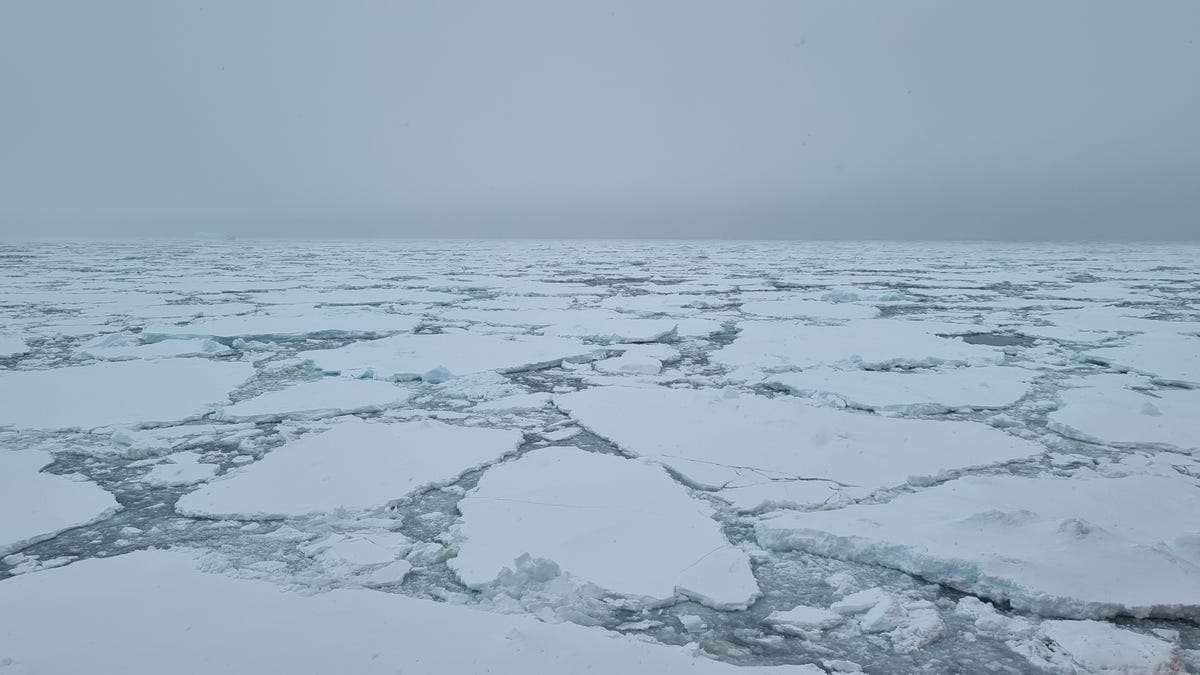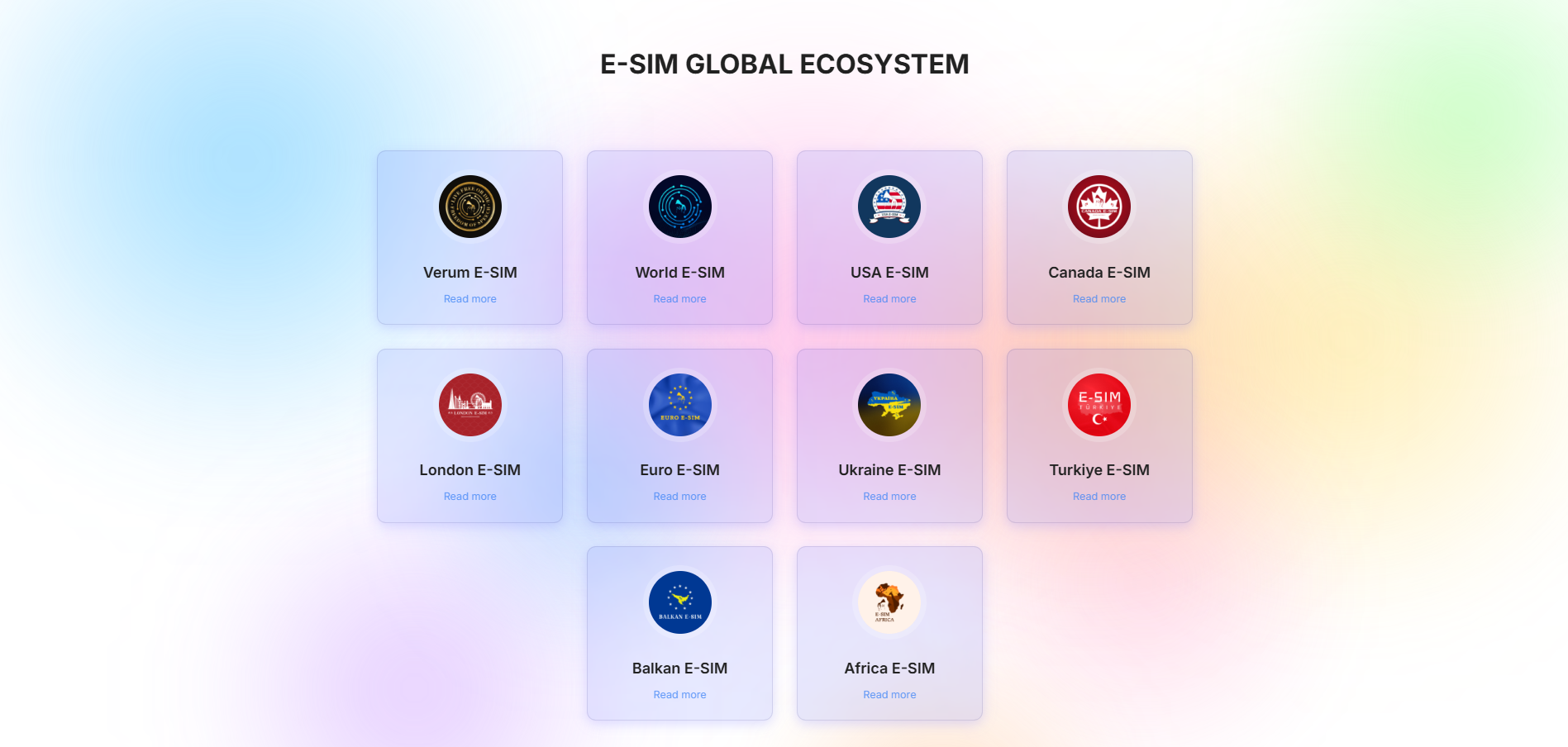Technologies
As a ‘Sea Ice Free’ Arctic Looms, the Climate Consequences Are Mounting
Research points to a milestone in the 2030s, but sea ice is already disappearing at an unprecedented rate. And that affects all of us.

The sound of ice cracking underneath the hull of a 25,500-ton icebreaker is unmistakable. No matter where you are — shuffling along the lunch line in the galley or sitting on the observation deck with a pack of cards — the wincing of steel and crunching of ice can shriek through the ship. It’s almost ghostly; undeniably haunting.
The sight of the ice? That’s mesmerizing. From the deck of Australia’s icebreaker, the RSV Nuyina, on which I sailed to Antarctica for more than five weeks at the start of 2022, it’s like looking out over a Martian landscape that’s been covered in a coat of stark white paint. In the distance, castles of ice rise from the vast, unbroken ice sheet. At the foot of one fortress, a battalion of King penguins lurks, unfazed by the freezing temperatures. Behind the ship, smaller Adelie penguins avoid a scrap with a leopard seal by climbing onto an island of ice and scurrying away.
Sea ice is vital to the Antarctic ecosystem. It’s not just a refuge for penguins and other animals, but a fundamental facet of life for creatures further down the food chain too, like Antarctic krill. It means life. The ice is also critical for heat because it’s more reflective than water, bouncing back more sunlight than the ocean, and it can act as a physical barrier, impacting the exchange of gases between the ocean and the atmosphere and protecting the continent’s ice shelves.
The Antarctic is currently experiencing the lowest level of sea ice since satellites began taking measurements in 1979. It’s an anomaly scientists are concerned about and monitoring closely. It was just a decade ago that sea ice in the Antarctic reached record highs, but generally low extents have been observed since 2016. It’s worrying, and could signal a shift in the sea ice dynamics down south, but the situation is more dire at the opposite end of the planet.
There, at the Earth’s northern extreme, the Arctic is experiencing an increase in temperatures two to four times higher than anywhere else in the world, and sea ice has decreased by about 12% per decade since the beginning of the satellite era. About 548,000 square miles of sea ice has been lost since 1979, equivalent to losing an area of ice roughly half the size of India. It’s seen a more rapid decline since 2000.
It’s one of the most obvious signs that greenhouse gas emissions are shifting the planet’s equilibrium. Researchers say we can take steps to slow the changes, but we need to act with urgency.
The 4 million people who call the Arctic home rely on the Arctic Ocean for food and transportation. The Indigenous peoples of the Arctic, who make up about 10% of the population, have a vibrant and longstanding cultural connection to the region that is slowly dripping away as regions become free of sea ice for the first time in millennia.
Meanwhile, the distribution of wildlife is shifting and behaviors are changing, altering the interactions between predators and prey. The Arctic’s famous polar bears rely on the ice to hunt and now have to travel further to eat, whereas the narwhal, a near-mythic, tusked whale, faces increased threats from killer whales lingering in exposed, warmer waters and disruptions to its migratory patterns.
Our best models currently predict the Arctic will be «sea ice free» within the next few decades, perhaps as soon as the 2030s. Antarctica’s sea ice is more of a mystery. But at both poles, sea ice is disappearing at an unprecedented rate.
And when the ice ends it’s not just the ends of the Earth that will change. It’s the entire planet.
An already changed Arctic
The Arctic Ocean’s sea ice expands during the winter, peaking in March, before retreating toward the North Pole. It typically reaches its lowest extent in mid-September. It never completely melts away — the North Pole itself is typically surrounded, and up to a fifth of the ice in the Arctic is so-called multiyear ice, persisting for more than a year.
Our understanding of this rhythmic pulse in the Northern Hemisphere stretches back for millennia. Indigenous peoples of the Arctic have passed down knowledge of the sea ice’s extent for thousands of years, particularly around coastal communities. Iceland’s government has been keeping detailed records since the 1600s, while log books and diaries kept during early exploration by ship provide a surprising amount of detail on where and when the Arctic Ocean froze over.
Our ability to understand the ice changed dramatically with the launch of the Nimbus-7 satellite in late 1978. The NASA and NOAA polar-orbiting satellite was fitted with an instrument that provided a way to observe the extent of the sea ice all year round, no matter the weather conditions, by studying the microwave energy bounced back from the surface. Continuous records have been taken since 1979, and the analysis has been deeply troubling. The extent of Arctic sea ice has been decreasing across those four decades, with each of the last 16 years the lowest on record.
Video: Changes in Arctic sea ice
Video credit: NASA’s Scientific Visualization Studio
For decades, scientists have tried to pinpoint when the total extent of Arctic sea ice will drop below 1 million square kilometers (or about 386,000 square miles) — the marker denoting a «sea ice-free» summer. In 2009, for instance, one study used climate models to determine that this mark would be hit by 2037. Other research has shown that the timing is unpredictable, with analyses suggesting we might still be decades away.
In June, a study in the journal Nature Communications analyzed 41 years of satellite data, from 1979 to 2019, reiterating that human greenhouse gas emissions are the dominant force in reduction of Arctic sea ice. It also generated a flurry of worrying headlines focused on the first ice-free summer, citing the near end of a range that it said had shifted to as early as the 2030s to 2050s. But those headlines gloss over a critical point: The current losses of summer sea ice are already having devastating effects.
«Although the first ice-free Arctic summer has constantly been a point of interest for understanding and communicating climate change, it’s more a symbolic threshold in some sense,» says Zachary Labe, a climate scientist at Princeton University and the National Oceanic and Atmospheric Administration. «Arctic climate change is already happening now and in all months of the year.»
An Antarctic paradox
From the beginning of the satellite era until 2010, Antarctic sea ice experienced a slight increase, with an acceleration in winter sea ice extent between 2012 and 2014. This was unexpected. Global temperatures have unequivocally risen in this time, largely due to human-induced climate change, raising ocean temperatures. Sea ice should’ve been melting. It didn’t.
The phenomenon was dubbed the Antarctic paradox.
Many climate models haven’t been able to reproduce these effects, though at least one high-resolution model has had success. Though explaining the paradox has been difficult, scientists have several hypotheses.
Natalie Robinson, a marine physicist at New Zealand’s National Institute of Water and Atmospheric Research, points out that changing wind patterns, release of freshwater from Antarctica, and ocean stratification could all have played a role over the last four decades, but she says that pointing to one variable as a driver of the increase is virtually impossible. «In reality, all of these processes act simultaneously and influence each other,» she notes.
About seven years ago, the story began to change. Antarctic sea ice extent plummeted in 2016 and hasn’t totally recovered since. In 2023, winter sea ice extent is dramatically lower than we’ve ever seen in the satellite era.
«Antarctic sea-ice extent has now adopted a downward trajectory as expected under warming and is congruent with observations of surface warming in the Southern Ocean,» says Petra Heil, a polar ice scientist with the Australian Antarctic Division. Graphs generated by Labe show the stark decline.

The record low extent has scientists concerned. Understanding the paradoxical increase over the past four decades could help unlock the reasons behind this sudden change. Does it represent a shift to a worrying new normal? Or is it merely a blip that can be attributed to the normal range of variability?
«There is certainly a fair bit of concern in the scientific community that it’s the former,» says Robinson.
«And we are racing to find out.»
When the ice ends
The great white sheets at either end of the Earth are particularly good at reflecting sunlight. Sea ice covers about 15% of the world’s oceans across the year, and up to 70% of the heating energy is reflected back into space. Cover that ice with a dusting of snow and up to 90% can be reflected.
When the sea ice disappears, the energy is absorbed by the ocean, raising its temperature. «In a positive feedback loop this ocean warming leads to even more ice loss and global warming,» says Heil. She suggests conceptualizing the impact of sea-ice loss by thinking about sea ice as the air conditioning unit of the Earth.
When the sea ice disappears, our planetary AC unit is being switched off. It becomes harder to reflect that heat into space and we lose the ability to «self-regulate» the Earth’s climate.
The change doesn’t affect just the ocean surface and the Earth’s air temperatures, though. Sea ice also plays one of the most critical roles on the planet in the ocean’s depths. As seawater freezes into ice, salt is expelled, making the surrounding water denser. This heavier, colder water sinks and gets whisked around the planet. Warmer waters are predominantly pushed by wind into the polar regions, then freeze up into ice. The cycle is known as thermohaline circulation.
«This process can be regarded as the starting point/engine of the global oceans’ overturning circulation,» says Jan Lieser, a sea ice scientist with the Australian Bureau of Meteorology and University of Tasmania.

As the oceans continue to warm at both poles and sea ice extent decreases, this deep ocean current is likely to be disturbed. The knock-on effects could disrupt the polar ecosystems as nutrients and ocean biogeochemistry are altered, particularly in the Southern Ocean, where circulation is also heavily influenced by Antarctic meltwater and the currents already show signs of slowdown.
The atmosphere and ocean systems are incredibly complex and intertwined. Though the focus has long been on the extent of the sea ice, thickness also plays a role. So does snow cover. These measurements are harder to include in models because they’ve traditionally been difficult to gather. There are also differences at either pole. The Arctic typically has had thicker sea ice lasting for years, whereas Antarctic sea ice freezes new each year.
It now seems highly unlikely that the current declines can be stopped but Heil, and her colleague Melinda Webster from the University of Washington, say «it’s possible to slow and mitigate further detrimental effects of a warming climate by reducing greenhouse gas emissions and implementing ways to reduce existing atmospheric greenhouse-gas concentrations to levels that can sustain a habitable climate.»
On June 16, Heil and Webster, and more than 60 other polar scientists responded to the changes to the poles by calling for «urgent intensification of national and international research and observational capabilities in view of rapid Arctic and Antarctic change.»
«Action is required now,» she says, «to give future generations a fighting chance to mitigate the negative consequences of a warming climate.»
The anomaly in Antarctica’s sea ice this year, as if sounding its own alarm and affirming Heil’s calls, has only continued its downward trajectory.
Technologies
Aflac Reveals Just How Big Its Data Breach Really Was
The insurance company says the compromised information included Social Security numbers and health insurance information.

Following up on a data breach that it first reported in June, insurance provider Aflac revealed in December that the incursion compromised the personal data of 22.65 million people. In its update, the company said that files containing personal data related to customers, beneficiaries and employees may have included contact information, claims, health information and Social Security numbers.
Aflac said it addressed the breach within hours and began notifying customers soon after. On its homepage, Aflac has a link to a PDF document that includes details on what it’s offering customers to address the breach, including 24 free months of CyEx cybersecurity services.
Don’t miss any of our unbiased tech content and lab-based reviews. Add CNET as a preferred Google source.
The service includes credit monitoring, medical information protection services and identity theft monitoring.
In a press release, the company downplayed the effects of the data breach. «To date, Aflac is not aware of any fraudulent use of personal information and —along with third-party partners —will continue to monitor any fraudulent activity,» it said.
A representative for Aflac told CNET the company has no further comment beyond what it has posted on its website.
The businesses you interact with — insurers, health care providers, financial services companies, retailers and so on — are a trove of personal information about about you that cybercriminals are constantly trying to access. Some ways you can protect your private data include locking your Social Security number, improving your passwords and being on guard against phishing.
Technologies
I Tested the Huawei Pura X: This Wide-Screen Flip Phone Is Refreshing and Fun
Huawei’s Pura X is the wildest flip phone to exist and one of the only two foldable phones that I’ve loved watching videos on.

I’ve tested several flip phones in the past, but I never stuck to any. My lifestyle doesn’t require a phone that folds into a smaller footprint to fit inside my pocket. There’s a market for them, no doubt, but when I’m using a foldable phone, I want it to expand the capabilities of my current phone. And that’s why I’ve loved using the Huawei Pura X.
Most flip phones are narrower and taller than traditional smartphones. They have big 6.9-inch screens with a 21:9 aspect ratio, but the Pura X is unique by design. It has a smaller 6.3-inch display with a wider 16:10 aspect ratio, making it an ideal screen for reading and video consumption. The Huawei Pura X is a refreshing take on flip phones. It is closer to a mini book-style foldable than a flip phone. In fact, I have enjoyed using it more than the Motorola Razrs and Galaxy Z Flips of the world.
Huawei Pura X: What’s it like to use a wide-screen flip phone?
I couldn’t use the Pura X as my primary phone because it is a China-only device. So, most of its preloaded apps are in Chinese. I installed a few Google apps like Chrome and YouTube, among others, to make the experience as close as possible to my main device.
In the last 10 days, I’ve loved consuming content, both video and written, on the Huawei flip phone. It combines the pocketability of a flip phone with the readability of a book-style fold in a single device — while also delivering a better video-watching experience than both of them.
The Pura X unfolds to a 6.3-inch AMOLED display with support for a dynamic 120Hz refresh rate, 2,120×1,320-pixel resolution and 2,500 nits peak brightness for supported HDR content. These specs might seem similar to the iPhone 17, Galaxy S25 and Google Pixel 10, but the Pura X has a wider 16:10 aspect ratio (versus 20:9 on slab phones). Its biggest benefit is immediately noticeable when watching movies and YouTube videos.
The video consumption experience on foldable phones typically isn’t ideal. They usually have huge letterboxing (thick black borders) on either top and bottom (on the Galaxy Z Fold 7) or left and right (on the Galaxy Z Flip 7). Movies shot in 21:9 fare better on flip phones but worse on book-style foldables. The Huawei Pura X minimizes this letterboxing with its 16:10 screen, while also offering a similar on-screen watchable area.
This might surprise many, but as you can see from the above photo, you get a larger video viewing area on Huawei’s 6.3-inch display than Samsung and Motorola’s 6.9-inch flip phone screens. In fact, 16:9 YouTube videos on the Pura X are almost as big as on the Galaxy Z Fold 7 (in the slightly wider horizontal orientation). This is only the second time I’ve loved watching videos on a foldable phone (the first was the Huawei Mate XT trifold phone, also for its increased viewing area with a 16:11 aspect ratio, when fully unfolded).
It also provides a pleasing reading and web browsing experience — you just need to rotate the phone in vertical orientation. By design, the Pura X is slippery, and its wider design doesn’t help the in-hand grip. Thankfully, it weighs under 200 grams, so it isn’t as heavy as modern flagship phones. I got used to it within a few hours.
Another learning curve was getting used to the placement of buttons and unfolding it like a Fold (from the right side) instead of a Flip (from the bottom). The latter was easy, but I still struggle with the former.
When you unfold the Pura X, you need to rotate it by 90 degrees to change its orientation to use vertically. Huawei’s user interface doesn’t allow you to use the phone horizontally. So, every time I open the Pura X, its volume rockers and power button (with a built-in fingerprint scanner for biometric authentication) swap places.
The fingerprint sensor that resides on the natural resting place on my thumb (when the phone is folded) moves to the top of the phone when it is unfolded. I have added my index finger data to unlock the phone, and it might not be a big deal in the long term, once my muscle memory has gotten used to it. But so far, it has been slightly bothersome to get a mention here.
The rest of the specs and features
The Huawei Pura X has a 3.5-inch OLED cover screen with a 980×980-pixel resolution and the same dynamic 120Hz refresh rate. It isn’t as large as Samsung and Motorola flip phones, but it can run a full-fledged browser and multiple first-party apps. This 1:1 display is also good enough to capture selfies using the rear cameras, of which you get three.
Huawei has included a 50-megapixel primary camera with an f/1.6 aperture. It is accompanied by a 40-megapixel f/2.2 ultrawide-angle sensor and an 8-megapixel telephoto camera with support for a 3.5x optical zoom.
For context, most flip phones have only two rear cameras, but the Pura X’s optics are as versatile as a slab phone. The camera performance is similar to what you’d expect from a Huawei phone: smooth and brightened skin tones, good dynamic range and rich details.
The Huawei Pura X is powered by last year’s Kirin 9020 chipset and has up to 16GB of RAM and 1TB of storage. My unit runs on HarmonyOS 6.0, which is smooth and fluid in day-to-day use. It packs a 4,720-mAh battery with support for 66-watt wired superfast charging and 40-watt wireless fast charging.
The Pura X is for those who want the best video consumption experience on a foldable phone, without compromising portability and cameras. It was launched earlier this year at a starting price of 7,499 yuan (roughly $1,065) for the 12GB RAM and 256GB storage version. However, it received a price cut recently and is now selling for 6,899 yuan (roughly $980).
After using the Huawei Pura X, I can confidently say that wide-screen foldable phones have their own place in the niche category. It has made me more excited for the rumored 4:3 iPhone Fold and Samsung «Wide Fold» in 2026.
Technologies
Verum Messenger Introduces Its Own Next-Generation eSIM Technology
Verum Messenger Introduces Its Own Next-Generation eSIM Technology

Digital mobile connectivity is evolving rapidly, and eSIM is becoming a key element of this transformation. The Verum Messenger team has developed and launched its own eSIM technology, designed for users who value freedom of communication, the absence of roaming, and independence from operator restrictions.
Verum eSIM is a virtual SIM card that works without a physical carrier and provides mobile internet access in different countries around the world under unified conditions. Users simply install the eSIM on a smartphone, tablet, Wi-Fi router, or any other supported device — without visiting a mobile store and without replacing a SIM card. From the very beginning, the technology was designed as a global solution, not tied to a single operator or region.
Verum eSIM offers a range of regional and international plans: World eSIM (global coverage), London eSIM, USA eSIM, Euro eSIM, Africa eSIM, Türkiye eSIM, Canada eSIM, Balkan eSIM, Ukraine eSIM. The key difference is the absence of traditional roaming. Users receive stable mobile internet in multiple countries without sudden tariff changes or unexpected charges.
One of the core features of the technology is its operation without a physical SIM card. This minimizes dependence on local operators, allows users to bypass network restrictions and blocks, and enables effective use of eSIM in countries with strict internet censorship, including Russia. When using only the Verum eSIM profile, connection flexibility and privacy levels are significantly increased.
A separate advantage of Verum eSIM is full support for eSIM-enabled Wi-Fi routers. All available plans can be used not only on smartphones but also on compatible eSIM routers, providing internet access to multiple devices at once. Such a router can serve as the primary internet source at home, in the office, while traveling, in cars, on yachts, or in temporary locations, automatically connecting to available networks in different countries without being tied to local operators.
The Verum team focuses on affordable and transparent pricing. Plans are structured to be competitive compared to local operators and traditional international roaming. Users know the data cost in advance and do not encounter hidden fees.
For user convenience, Verum eSIM supports a wide range of payment methods, including bank cards, cryptocurrencies, and alternative payment solutions. This makes the service accessible to users from different countries with various financial instruments.
Verum Messenger and Verum eSIM are not just an eSIM service, but a step toward rethinking mobile connectivity as a global, open, and independent technology. No roaming, no physical SIM card, no territorial limitations — a new standard of mobile internet, truly worldwide.
-

 Technologies3 года ago
Technologies3 года agoTech Companies Need to Be Held Accountable for Security, Experts Say
-

 Technologies3 года ago
Technologies3 года agoBest Handheld Game Console in 2023
-

 Technologies3 года ago
Technologies3 года agoTighten Up Your VR Game With the Best Head Straps for Quest 2
-

 Technologies4 года ago
Technologies4 года agoBlack Friday 2021: The best deals on TVs, headphones, kitchenware, and more
-

 Technologies4 года ago
Technologies4 года agoVerum, Wickr and Threema: next generation secured messengers
-

 Technologies4 года ago
Technologies4 года agoGoogle to require vaccinations as Silicon Valley rethinks return-to-office policies
-

 Technologies4 года ago
Technologies4 года agoOlivia Harlan Dekker for Verum Messenger
-

 Technologies4 года ago
Technologies4 года agoiPhone 13 event: How to watch Apple’s big announcement tomorrow
